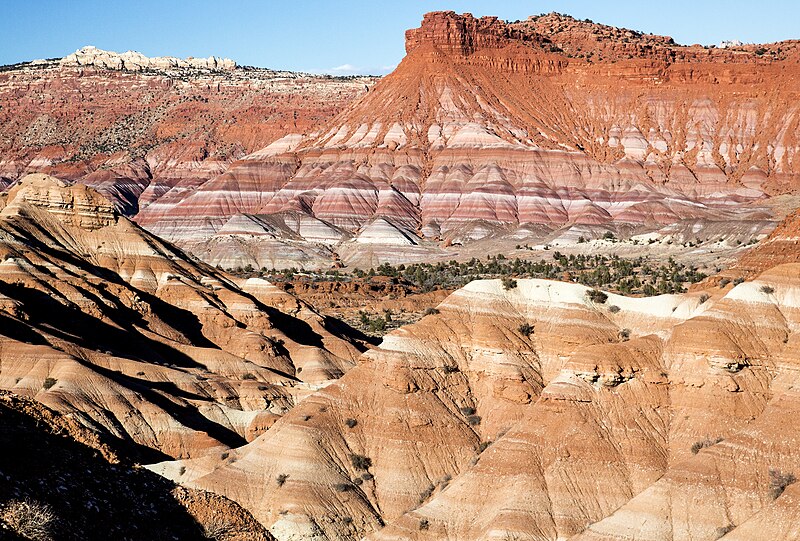Grand Staircase-Escalante National Monument, Utah
Disappearance in the Desert:
Everett Ruess
Welcome to Weird Wednesday! Today we’re off on a journey into the deserts of Utah in search of someone who’s there…but in some sense nowhere.
Missing persons are a particularly distressing problem for the human mind. We don’t like ambiguity. We don’t like to think of a bewildered family. We don’t like to conceive of circumstances that could allow a person to just vanish. No wonder we’re fascinated with adding to Wikipedia’s Solved Missing Persons Cases.
Unfortunately, the question of Everett Ruess will likely never be answered. For one, it’s been 90 years since Ruess disappeared, and for two, he did it in a particularly difficult place to search: isolated rocky desert, beautiful and barren.
Everett Ruess was a 20-year-old artist who loved the adventure of traveling the Sierra Nevada mountains and the American Southwest. He wrote poetry and kept a diary where he spoke of his love for the outdoors and exploration. Sometimes he joined up with others on expeditions, but often he journeyed alone. He was alone on November 20, 1934, when he walked into the Utah desert, in what is now Grand Staircase-Escalante National Monument, and never returned.
No one raised the alarm for a few months, because Ruess was often out of touch for long periods. But when his parents started receiving their son’s uncollected mail in February of 1935, a frantic search began. Soon after, Ruess’s campsite was found near Davis Gulch, with two donkeys in a corral he’d built. But no further concrete sign of him was ever discovered. Somewhere out there, amid starry skies and stark canyons, something went very wrong for Everett Ruess. And we have no idea what it was.
Unfortunately, there are a lot of ways for a person to vanish in the wilderness. Nature is the usual answer: Ruess might have been caught in a flash flood, or he might have died of exposure or a fall. It’s tempting to think that Nature would at least leave a body to be found, but predation by animals and a changing landscape could easily hide human remains.
Of course, foul play is also an option. While the remote Utah desert was isolated, it was not completely unpopulated. While Ruess held racist opinions toward local Native Americans, there’s no evidence of aggression between Ruess and anyone else, and no sign he committed suicide.
In 2009, a set of remains found in the area was theorized to belong to Ruess, but DNA testing proved they actually belonged to a missing Native American, which at least put an end to some of his family’s questions.
The fate of Everett Ruess appears to be an unsolvable mystery, something equally irritating and fascinating, and, as it happens, good for writing prompts.
- Aliens. Let’s get this one out of the way first. Alien abduction is such a tempting explanation for missing people. A flying saucer comes along and beams somebody up and there’s nothing left to find. No trail, no body, no further bank account activity. There are a few ways to go here when plotting a story. Obviously, alien abduction makes for good horror. But it could also be a sci-fi adventure, historical mystery, or an interspecies meet-cute (guess which one’s my favorite)?
- Back to reality. Disappearances are traumatic events, and as such, they aid in the telling of literary stories which examine the effects of trauma on a group of people. The novel Jaws (not so much the movie) did the same thing. So how would a family deal with such a loss, with no answers ever forthcoming? Or a team of searchers, college campus, or a group of internet sleuths? In a literary take, the focus is not so much on what happened to the missing person, but to the people left behind.
- Rumors of my death. Of course, in some cases of missing people, the mystery is fabricated. Occasionally people just walk away from their lives, and sometimes they go as far as faking a kidnapping or even their own death. Typically, investigators look for signs like the person talking of starting over, or draining their bank account before disappearing. But faking one’s own death would entail cruelly breaking ties with family and friends and everything else in the life left behind. What would drive your character to do this? And what would happen if after 20 years, they suddenly reappeared?
- Follow in my footsteps. Wilderness missing persons cases can become obsessions for family, friends, fellow adventurers, and internet strangers. Unfortunately, sometimes people take unnecessary risks in trying to solve the case, which can lead to injury, death, or even a second vanishing. Let’s say your character is determined to find someone who went missing in the desert, from a motive of grief, fascination, or a desire to help. How would they react to getting lost themselves and realizing they had become another vanishing?
- The answer. Let’s say your character has solved the mystery! They found a skeleton, murder confession, suicide note, trail that led to edge of a cliff, or proof the person had faked it all. But they can’t tell anybody. Your job as writer is to decide why not. Is it a secret guarded by the government or the mob? Does the “missing person” themselves beg your character not to give away the answer? Does the evidence implicate your character’s friend or family member? Or is the truth just too terrible to reveal?
Thanks for spending your Weird Wednesday here! Remember, when hiking in the wilderness, a little precaution can keep you from becoming an internet mystery.
Want more Weird Wednesday wilderness? Check out The Donner Party.
Want to chat about the blog? Did you use one of the prompts? Hit me up on social media.
If you like spooky tales of the West, feel free to check out Queer Weird West Tales, which contains my story The Train Ticket: A man holds a ticket to Hell after accidentally robbing a ghost train.
And if you like stories about mysterious vanishings, you can read my story Devoured for free in Nocturne Horror Magazine. A woman tries to convince her grief-stricken mother to move out of a haunted house.
Sign up for my free monthly newsletter and never miss a blog post! Or subscribe by RSS
Everett Ruess: Wikipedia
Putting Everett Ruess to rest: Perhaps a final conclusion to a 1934 desert mystery: The Durango Herald
Everett RUESS: Utah Department of Public Safety
Efforts to find Everett Ruess proved more difficult than anticipated: The Daily Sentinel
Eccentric artist-adventurer remains missing in Utah desert after 88 years: The Daily Sentinel


